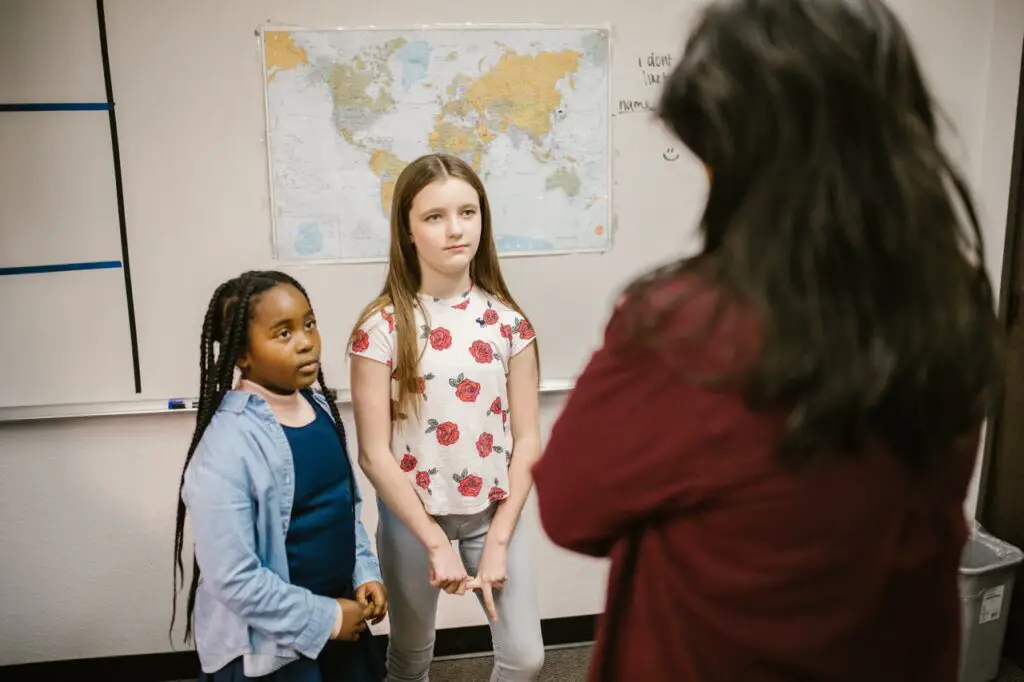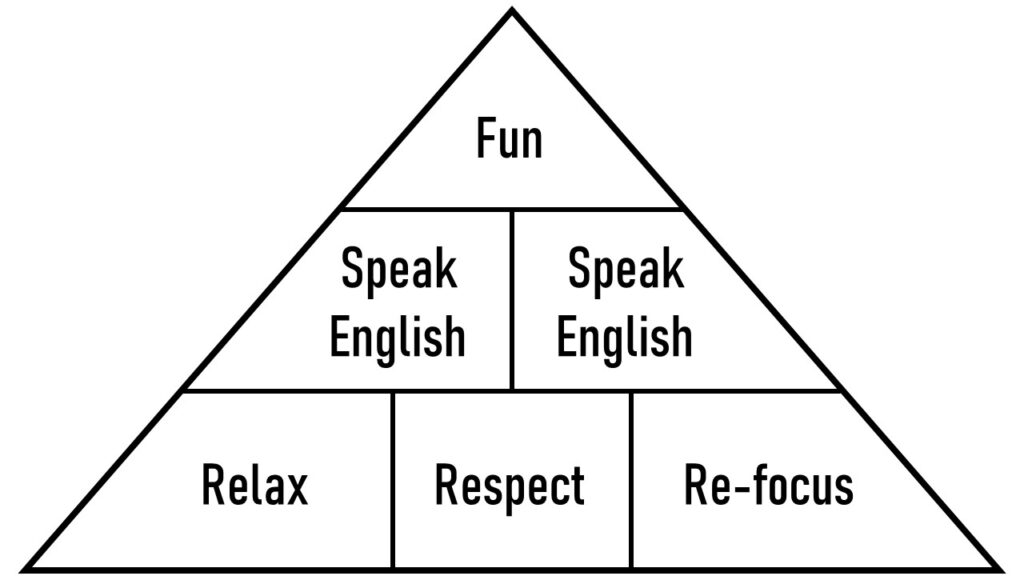Knowing what to do in your first private EFL/ESL class with a new student (or small group) can be daunting. Will they be shy or confident? What will their level be? It’s hard to predict what’s going to happen.
That’s why I’ve prepared these lesson plans for you to use. There’s one for classes of children aged around 8 and above, and another for older teens (16+) and adults.

The plans here are based on my article Acing Your First Private EFL/ESL Class: 9 Steps to Success which covers all aspects of the first class with a new student/group. If you haven’t read that yet, I recommend you do so in order to understand the reasoning behind these plans.
As I explain in that post, flexibility and preparation are the keys to success. We want to design a lesson which we can adapt, and that involves preparing plenty of extra activities and adjusting as we go.
These plans follow the philosophy outlined in my big guide, Principles of Designing Amazing Private EFL/ESL Lessons. For the full process of lesson planning, make sure to read that, too.
The two lesson plans in this article are:
- For a duration of 1 hour
- Designed with minimal materials and equipment needed (pen and paper and a whiteboard/mini whiteboard)
- Open to adaptation to suit your requirements.
Before we get to the nitty gritty of the lesson plans, let’s quickly look at what the intention of this first class is. Or, click to skip straight to the lesson plan for children or the lesson plan for adults.
And here are links to PDF files with outlines of the lesson. Make sure you read the information in this article first to understand it all.

Get My Free Lesson Plans
- Monthly themed lessons
- Access to all previous plans
- Printable game materials
- Role play scenarios
- Monthly newsletters with more free stuff!
What are the aims of the first class with a new private EFL/ESL student/group?
The first class with a new student/group is all about getting to know each other and creating connections. The four main aims are:
- Needs Analysis – learning the students’ abilities, preferences, goals and areas to improve.
- Finding common interests to develop connections and inform future lessons.
- Establishing expectations for both the student(s) and the teacher.
- Creating a positive, welcoming environment where learning can reach its potential.
It may sound weird, but you don’t actually need to teach anything in this first class. It’s a fact finding mission.
Performing a needs analysis is the main aim, and we will base most of the activities on achieving this.
For more on doing a needs analysis, check out my in-depth article here: Needs Analysis for Private EFL/ESL Lessons: 12 step guide.
As part of the needs analysis, we try to find out what makes the student(s) tick. What are their hobbies and passions? What do they enjoy talking about, and what things do we share interests in which we can use as the theme of activities going forward?

We should also build in some time for setting goals and expectations. With adults, telling them what they can and can’t do is a bit patronising, so it’s best to focus on what they want to achieve and how you’re going to get there. Children, however, need limits defined clearly.
I’ve got a great article on how to set expectations with children in EFL/ESL. Find it here: How to Set Rules & Expectations in Private EFL/ESL Classes.
Setting expectations explicitly is vital, right from the start. But throughout the class, we’ll also be setting the tone implicitly. We do that through the type of activities we do, and the way we treat the student(s).
With all that in mind, let’s get to the first lesson plan for a class with children.
Lesson Plan: First private EFL/ESL class with children
If you want to see the lesson plan for ADULTS, click here to skip straight to it.
This lesson plan is for children aged 8 and above, either as individual students or in small groups (no more than 5). You can potentially do it with younger kids, as long as you’re confident they’re capable of making simple sentences in longer conversations.
It consists of four phases:
- Greeting and expectations (15 minutes)
- Getting to know each other chat (15 minutes)
- Main activity (20-30 minutes)
- Roundup game (5-10 minutes)
Don’t get too stressed about timing. Some parts may stretch on longer than others, while in some cases you might have time to spare at the end. That’s okay. It’s why I always recommend preparing extra activities.
Here’s a PDF with an outline of the plan:
Let’s look at each phase in detail.
1. Greeting and expectations (15 minutes)
In brief:
- Introduce yourself and say a few things about you.
- Ask students to introduce themselves and say one or two things they like/dislike.
- Ask why students are in the class. What are their motivations?
- Establish expectations using the Perfect Pyramid.
GUIDANCE AND ADVICE
This is your first interaction with the new student(s) in a private class situation. You’re going to learn a lot about them in this time.
First, introduce yourself and tell them a couple of things about you.
Then ask them to introduce themselves and say something they like or dislike. You can structure this by asking them specific questions like “What’s your name? And what’s your favourite colour/food/sport?” Choose a question you think is appropriate for their level of maturity.

They’re going to speak for the first time now. Pay attention. How do they answer the question? Individual words with lots of empty space? Or do they use full and accurate sentences?
“How old are you?” is often a good one to ask, especially with speakers of Latin-based languages, as they may make the common mistake of saying “I have ten years old.” Note any mistakes like that, but at this point you don’t need to go hard on corrections.
The next thing you want to ask about is why they’re here. For younger kids, they might not have a great answer for this, but anyone aged ten or more should be able to tell you something. Whatever they say (even if it’s because their parents are forcing them), it’s important to note.
Use this to transition into talking about expectations. If they seem quite chatty already, let them contribute and make suggestions. If not, take the lead and walk them through step by step.
Here’s the link to my process of setting expectations – How to Set Rules & Expectations in Private EFL/ESL Classes. And below you can see the Perfect Pyramid.

2. Getting to know each other chat (15 minutes)
By now, you should have a good idea about how talkative your class is going to be. Are they confident speaking, or are they very shy?
You can choose one of the following approaches, depending on your student(s).
- Start an extended conversation, using focused and follow-up questions. This is best for students who are confident talking already.
- Ask students to write down the answers to a few focused questions and share them orally afterwards. This is for less chatty classes.
Essentially, you’re doing the same thing, but in the second approach, you’re allowing students time to relax without sforcing them to talk all the time.
GUIDANCE AND ADVICE
I recommend you prepare your own list of questions based on the age and background of your specific students, but here are some generic examples:
- Where are you from?
- Tell me about where you live.
- What’s your favourite movie/series, and why?
- Are you a sporty person?
- What sports do you like playing? And watching?
- Do you prefer reading books or watching TV?
- When was the last time you went on vacation?
- Would you like to go on vacation to New York?
- What did you do earlier today?
- What are you going to do at the weekend?
- If you had a free day tomorrow, what would you do?
Make sure to include some shorter yes/no style questions as well as open-ended ones. See how your students respond to both. Do they give lots of extra information, or just say the bare minimum?
Try out some more advanced grammar structures, too. Notice on my list of questions, the first ones are relatively simple, but the ones at the end require the past, present and even the second conditional.
Pay attention to the strengths and weaknesses of the grammar they use. Don’t try to correct or explain things they get wrong at this stage – you can focus on all that in future lessons.
3. Main activity (20-30 minutes)
Again, the choice of activity here depends on what you’ve seen so far.
There are three activities/games I’d suggest.
- Folding stories. It’s a fun, creative activity which you can do with students who are less confident at speaking. It’s intermediate level, but you can remove some parts to simplify it if needed. Go to my description of it here: Folding stories.
- Memory Chain. This allows a little more speaking, but doesn’t put pressure on students to talk at length. You can also start using gestures, too. It’s part of my high energy vocab games list and you can find it here: Memory Chain.
- Say and Draw. For students who feel more confident about talking extensively, Say and Draw is a simple way of letting them do just this. Click to see the instructions here: Say and Draw.

Alternatively, choose your own activity or game. Just bear in mind, the best activities at this point are simple. You don’t want to spend a long time explaining rules, because if it’s too complex, your students will get frustrated. Not a good way to start.
Remember, throughout this activity, observe the strengths and weaknesses of your students, as well as how they interact with others (if they’re in a group).
4. Roundup game (5-10 minutes)
A short, fun game is a good way to finish the class. It may only be five minutes if the main activity went on for a while, but it can be 15-20 minutes if the earlier phases went by quickly.
My go-to game is Hot Potato. It’s great for pretty much every group since it’s physical, exciting and leads to plenty of laughter. You can also play it for just a couple of minutes, or keep it going for 15 or more.
Find out the instructions for Hot Potato here: Hot Potato.
However, Hot Potato might be a bit too much for very shy students. Instead, consider Who Am I (or What Am I?) or What’s Changed?
Regardless of which game you choose, have at least one more prepared, just in case. My list of 9 EFL/ESL 5 Minute Games Every Teacher Needs to Know is a great place to go for inspiration.

Get My Free Lesson Plans
- Monthly themed lessons
- Access to all previous plans
- Printable game materials
- Role play scenarios
- Monthly newsletters with more free stuff!
Lesson Plan: First private EFL/ESL class with adults
This lesson plan is for older teens (16+) and adults. If you missed the plan for children, click here to go to that section.
The plan consists of four phases:
- Greeting and goals (10 minutes)
- Getting to know each other chat (20-25 minutes)
- Main activity (30 minutes)
- Roundup (2-3 minutes)
Don’t stress the timings. They’re rough guidelines rather than rules. You may want to spend much longer getting to know each other, or focus more on the main activity. Always have something in reserve if things go short.
Here’s a PDF with an outline of the plan:
1. Greeting and goals (10 minutes)
In this part, you should:
- Introduce yourself and say a few things about you.
- Ask students to introduce themselves and say one or two bits of personal information (career, hobbies, etc.).
- Ask why students are in the class. What are their goals for learning English and what do they think they need to do to achieve them?
GUIDANCE AND ADVICE
This may be the first time you’ve had this kind of conversation with your new student(s). You want to set the tone early.
Introduce yourself and tell them a little about you. Then ask them to do the same. If they struggle, offer some prompt questions like: “where do you study/work?” or “what hobbies do you like?”
Ask why they want classes with you. Find out their motivations and what they want to achieve in these classes.

What you learn here will inform your lesson planning going forward. Goals may be “improve my fluency through conversation” or “prepare for the Cambridge First exam”.
Let them know they’re in control. You’re at their service to provide the kind of lessons they want, so they shouldn’t be afraid to give feedback or suggest activities or topics they want to focus on. Some, though, will prefer it if you prepare and organise everything.
2. Getting to know each other chat (20-25 minutes)
This phase of the class is where you first establish connections. Hopefully you’ll know a little about your student(s) before the class (age and gender at a minimum), so you can prepare questions to find out what makes them tick.
Look for things that you have in common. Follow up with more questions to dive a bit deeper when they express interest in something.
GUIDANCE AND ADVICE
While I suggest you prepare your own questions, here are some generic examples:
- Where are you from?
- Tell me about where you live.
- What’s your favourite movie/series, and why?
- Are you a sporty person?
- What sports do you like playing? And watching?
- Do you prefer reading books or watching TV?
- When was the last time you went on vacation?
- Would you like to go on vacation to New York?
- What did you do earlier today?
- What are you going to do at the weekend?
- If you had a free day tomorrow, what would you do?
Include yes/no style questions as well as open-ended ones. See how your students respond to both. How much extra information to they give?

Test more advanced grammar structures, too. Notice on my list of questions, the first ones are relatively simple, but the ones at the end require the past, present and even the second conditional.
Pay attention to the strengths and weaknesses of the grammar they use. Don’t try to correct or explain things they get wrong at this stage. You can focus on those aspects in future lessons.
3. Main activity (30 minutes)
This is the most open phase of the lesson. What you do here will depend on what goals and motivations your student(s) have expressed earlier in the lesson, and also their level and confidence.
For each common situation, here are some ideas. You should be prepared to do any of them, so I’ve kept them simple, without requiring lots of materials.
- For students who want conversation: Continue from phase two, but focus on something in particular. Vacations are a good topic to start with. Ask them about their favourite vacation, where they’d like to go, where they went last summer, etc. Or, pick up on something they were excited about in part 2, and go even deeper.
- For students who want grammar practice: Talk about what grammar they struggle with. Consider asking a few questions from a placement test to identify specific strengths and weaknesses. There are plenty of placement tests at ISL Collective. I wouldn’t do it all in class, but pick out a few questions and maybe set the whole thing for homework.
- For students who want exam preparation: Identify the exam they’re doing. Look together at the specifications and discuss when/where they’re going to take it. You may need to search the internet to do this. Draw up the outline of a plan together based on how much time you have and what skills you need to focus on.
- For students who want pronunciation practice: Find a list of words/sentences which are tricky to pronounce and get your student to say them, noting major difficulties. Here are some good ones on English Club. Talk about sounds that are different between English and your students’ language.
- For students who have no specific goals: Pick and choose between the activities above (except for the exam prep). If they’re chatty, keep the conversation going, but if they’re shy, focus more on the placement test questions.
IMPORTANT: I would also highly recommend preparing a general activity to use if you finish everything above early. If in doubt, keep a conversation going. Where you can’t do that, I’d suggest Two Truths and a Lie to practice a bit of sentence structure, while getting to know your student better.
Follow this link to where I explain how to play Two Truths and a Lie (with tips).
4. Roundup (2-3 minutes)
If you’ve been following the needs analysis steps (Missed that? read my guide Needs Analysis for Private EFL/ESL Lessons), by now you should have a pretty good idea of your students’ strengths, weaknesses and interests.
Right at the end of the lesson, share your findings with them. Focus on their strengths just as much as their weaknesses, so they don’t get disheartened.

Identify some things to work on and indicate what you’ll do in subsequent classes. This “hook” will give them something to look forward to and prepare for.
For example, with your student who wants conversation practice, you could say:
“You’re very good at talking about your hobbies and interests. You have lots of vocabulary and can express your feelings well. But I noticed you struggle a little when talking about the past. We’ll focus on that next week. We could discuss your time at school and university. What do you think?”
Remember to adapt and adjust
When you’re starting out as a private EFL/ESL teacher, lesson planning often seems rigid and prescriptive. It’s far from it. There’s an art to it, rather than just following instructions. You have to mold and sculpt each unique session.
So don’t follow everything to the letter. Take the parts you like and modify the ones you don’t like. Mix parts from two plans into one. That’s the whole fun of being a private EFL/ESL tutor – you can be creative!
And remember, you can get more of my lesson plans for free as an Enchanted ESL Newsletter subscriber!

Get My Free Lesson Plans
- Monthly themed lessons
- Access to all previous plans
- Printable game materials
- Role play scenarios
- Monthly newsletters with more free stuff!
Follow the links below to learn how to be the best private EFL/ESL tutor possible.
Ultimate Guide to Giving Great EFL/ESL Private Classes
Needs Analysis for Private EFL/ESL Lessons: 12 step guide
Principles of Designing Amazing Private EFL/ESL Lessons
Acing Your First Private EFL/ESL Class: 9 Steps to Success
Lesson Plans for First Private EFL/ESL Lesson (+ tips)
How to Set Rules & Expectations in Private EFL/ESL Classes
What to Do if Private EFL/ESL Students Won’t Participate
Getting EFL/ESL Exam Preparation Right: Tips for success
Give Amazing Private EFL/ESL Classes to Kids: 9 steps
7 Steps for Incredible Private EFL/ESL Conversation Classes
Teaching EFL/ESL Grammar: A guide for private tutors
5 Tips for Setting Homework in Private EFL/ESL Classes







